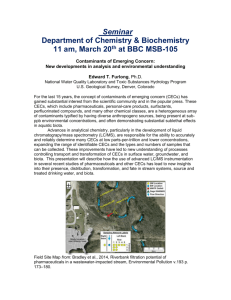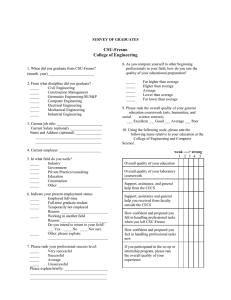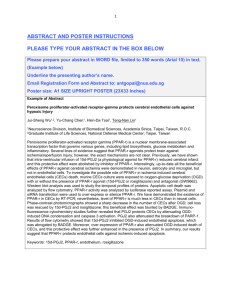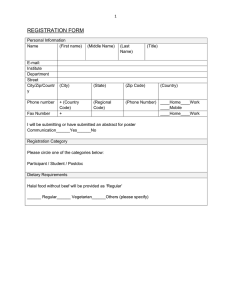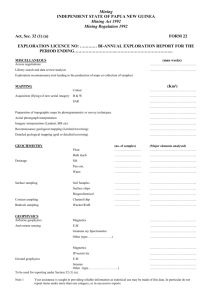College of Earth Resource Sciences and Engineering (CERSE) Overview Budget Strategies
advertisement
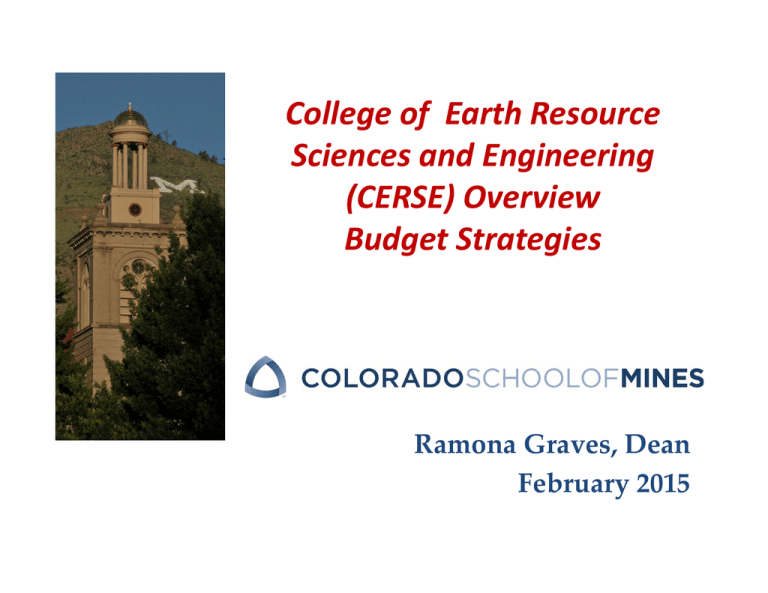
College of Earth Resource Sciences and Engineering (CERSE) Overview Budget Strategies Ramona Graves, Dean February 2015 2 CERSE Mission Exploit CERSE’s unique and global recognition to impact earth, energy, and environment education and research and to build a pipeline of future industry, academic, and government leaders. 3 CERSE Vision CERSE will be at the forefront in education and research and have a global impact in the areas of resource exploration and extraction, economics and policy while focusing on communicating broader societal impacts and disseminating this knowledge. CERSE Vision in Context of CSM Strategic Plan 4 Strategic Plan Goals Most Relevent to CERSE #1 Enhance distinctive identity and reputation of Mines #2 Build upon a student-centered campus culture of excellence, inclusion, diversity and community #3 Build and diversify revenue streams and auxiliary enterprises CERSE: Interdisciplinary, historic departments, industry focus, • • • applied and scientific research, communication, and social science/humanities education Large international and out-of-state undergraduate enrollment Extractive Industry Research – 63% of research is private/industry sponsored Strategic Enterprise Opportunities 5 CERSE Departments and Divisions • GEOPHYSICS • GEOLOGY AND GEOLOGICAL ENGINEERING • MINING ENGINEERING • PETROLEUM ENGINEERING • ECONOMICS AND BUSINESS • LIBERAL ARTS AND INTERNATIONAL • STUDIES COLORADO GEOLOGICAL SURVEY (CGS) 6 Mining Engineering FY11 FY12 FY13 FY14 FY 15 Undergrad Majors 93 103 117 118 119 Graduate Students 27 40 41 44 54 4,243 4,398 4,609 2,808 3,991 7 7 6 8 8.5 $1.4MM $4.6MM $5.7MM $1.3MM $3.0MM* Credit Hours Faculty Research Awards *Projected Growth in faculty - UCT with GE, CEE Edgar Mine; Earth Mechanics Institute (EMI) Revitalizing program: Revising UG curriculum, innovative research, strengthening grad program, multidisciplinary growth Make MN more competitive for Mines students Geology and Geological Engineering FY11 FY12 FY13 FY14 FY15 Undergrad Majors 161 151 139 154 150 Graduate Students 147 182 195 196 183 6,941 8,017 7,531 (8,247) 8,782 6,263 18 18 19 18 19 $2.7MM $4.3MM $5.9MM $4MM $4.5MM* Credit Hours Faculty Research Awards 7 Four discipline areas: Water, petroleum, economic geo, engineering geo (UCT) Undergrad teaching load - primarily due to service courses for freshman and PE Largest MS-thesis program at Mines primarily water and unconventional oil and gas *Projected 8 Petroleum Engineering FY11 FY12 FY13 FY14 FY 15 Undergrad Majors 463 503 646 739 889 Graduate Students 76 107 109 116 97 7,304 8,184 9,387 10,204 10,072 12 12 14 14 14.2 $5.2MM $5.7MM* Credit Hours Faculty Research Awards $1.8MM $2.8MM $5.9MM *Projected Undergraduate enrollment 2nd largest in US Dominate Unconventional Oil and Gas Education and Research Faculty constraint, large classes Innovative teaching (230 students: Logging – flipped classes; Drilling – 10 labs, 6 experiments in one lab section, 3 locations) 9 Geophysics FY11 FY12 FY13 FY14 FY 15 Undergrad Majors 79 92 109 129 135 Graduate Students 88 98 102 98 83 1,557 1,676 2,008 2,271 2,731 11 11 12 12 12 $5.2MM $7MM $4.5MM $6.2MM $6.7MM* Credit Hours Faculty Research Awards *Projected Highly recognized industry research-based grad program - Reservoir Characterization Project, Center for Wave Phenomena Broadening research beyond traditional strengths into areas such as planetary and whole earth Working with CGS/USGS on induced seismicity Jeff Andrews-Hanna 2013 10 Economics and Business Undergrad Majors Graduate Students Credit Hours Faculty Research Awards FY11 FY12 FY13 FY14 FY 15 56 45 26 28 20 151 144 115 148 113 8,736 8,170 8,417 7,938 8,436 14 14 15 15 14.5 $0.2MM $0.4MM $0.4MM $0.9MM $1.2MM* *Projected; Note: CMI $1.7MM ‣ Building grad program, struggling undergrad program ‣ Large service role ‣ Lead for Energy and Economic Policy Institute ‣ Lead for Critical Materials Institute (CMI) – DOE Hub 11 Liberal Arts and International Studies Graduate Students Credit Hours Faculty Research Awards FY11 FY12 FY13 FY14 FY15 19 29 18 14 12 10,952 11,527 14,502 14,934 14,373 23 24 25 25 28 $0.1MM $0.2MM $0.2MM $0.4MM $0.9MM* ‣ Large service role, no undergrad degree, struggling grad program ‣ Critical component of CSM engineering education ‣ McBride Honors Program, Humanitarian Engineering, Writing Center *Projected Undergraduate Students Fall 2014 CERSE, 1313; 31% 12 CASE, 1108; 26% CECS, 1828; 43% Economics and Geology and Business, 20; Geological Engineering, 150; 2% 11% Petroleum Engineering, 889; 68% Geophysics, 135; LAIS, 0; 0% 10% Mining, 119; 9% Graduate Students Fall 2014 CERSE, 542; 42% 13 CASE, 339; 26% CECS, 409; 32% CERSE Graduate Mining, 54; 10% Petroleum Engineering, 97; 18% LAIS, 12; 2% Geophysics, 83; 15% Economics and Business, 113; 21% Geology and Geological Engineering, 183; 34% Research Awards per College FY 14 CASE $24,772,872; 47% 14 CECS $9,295,530; 18% CERSE AWARDS CERSE $18,706,241; 35% Economics & Business, 848,835; 5% Petroleum Engineering, 5,169,273; 29% Mining, 1,344,412; 8% LAIS, 435,288; 2% Geology and Geological Engineering, 4,035,717; 22% Geophysics, 6,175,451; 34% Total Faculty per College FY 14 CERSE, 89.92; 33% 15 CASE, 86.56; 32% CECS, 101.5; 35% CERSE Faculty Petroleum Engineering, 14.2; 15% Mining, 8.5; 9% Liberal Arts and International Studies, 28; 29% Economics and Business, 14.5; 15% Geology and Geological Engineering, 19, 20% Geophysics, 12; 12% 16 Overview: Significant Growth in Many Areas FY11 FY12 FY13 FY14 FY 15 Undergrad Majors 872 894 1037 1168 1313 Graduate Students 508 600 625 611 542 39,733 41,972 46,454 48,109 46,657 85 86 91 92 89.9 $11.4MM $19.3MM $22.6MM $18.7 MM $22MM* Credit Hours Faculty Research Awards FY11-FY14 * Projected Undergraduate enrollment increased by 50% FY14 27% of undergrads Graduate enrollment increased by 6% FY14 45% of grad students Faculty increased by 6% FY14 34% of CSM faculty Research Awards increased by 93% FY14 37% of research awards Percentage of Mines International Students by Degree in CERSE Bachelor’s 77% Master’s 73% Doctoral 42% CERSE Hot Topics Rare Earths and Critical Materials (w/CASE & CECS) Water (w/CASE & CECS) Micro/Nano Pore Scale Studies (w/CASE & CECS) Hydraulic Fracturing (w/CECS) International Political Economy (w/CASE & CECS) Resource/Energy Economics and Policy (w/CASE & CECS) Underground Construction and Tunneling (w/CECS) Unconventional and Conventional Resources/Energy (w/CASE & CECS) Mine Automation (w/CECS) Scientific Visualization (w/CECS) Planetary Exploration (w/USGS) Geohazards (w/CGS) 17 18 Strong Research Culture in CERSE FY13 Total CERSE Research Awards MM FY13 Industryfunded Research Awards FY13 Governmentfunded Research Awards Co-PIs in Other Colleges Geology & Geological Eng $ 5.9 55% 45% CECS, CASE, CGS Geophysics $ 4.5 80% 20% CASE, USGS, CGS Mining $ 5.7 71% 29% Petroleum $ 5.9 58% 42% CECS, CASE, CERI, NREL EB/LAIS/CGS $ 0.6 1% 99% CECS, CASE Department CERSE Totals $22.6 63% 37% CECS, CASE, CERI, NREL 19 CERSE Partnership Initiatives Critical Minerals Institute (w/CASE) Earth Resource Institute (w/CECS & CASE) Water (w/CASE & CECS) Underground Construction and Tunneling (w/CECS) Unconventional and Conventional Resources/Energy (w/CASE & CECS) Unconventional Natural Gas Institute (UNGI) Geothermal Research Professional Education National and international regulatory training CO2 Sequestration Strategic Enterprise Opportunities Research and development - Kuwait/KOC University development - Kazakhstan/Nazarbayev University Industry education/workforce development - National and International: Poland, Morocco, Peru, etc..... 20 Pseudo - SWOT 1. Department/Division XX is emerging as… 2. Department/Division XX is great at… 3. Department/Division XX is in trouble with… 4. Department/Division XX initiatives… Liberal Arts and International Studies 21 LAIS is emerging as an important node of interdisciplinary research, teaching, and innovative educational programming on campus. Our new and emerging initiatives, areas of study, and minors engage faculty and students from across campus in addressing key questions relating to Earth, Energy, and Environment. LAIS is great at helping Mines students achieve the academic balance, overall intellectual growth of “the whole person,” and breadth of perspective on global events expected of graduates from prestigious universities. LAIS is in trouble with misperceptions of its role and mission at Mines (e.g., LAIS is only a “service department” and not central to the real work of the university). The attrition of tenure-line faculty and an imbalance in the numbers of tenure- and teaching-line faculty. LAIS initiatives serve to propel CSM towards its reputation of excellence. LAIS seeks to develop courses and course programming that respond to the needs of CSM at large; and to continue to develop interdisciplinary efforts in ethics, humanitarian engineering, McBride, and the Writing Center. 22 Economics and Business EB is emerging as a defining event for CERSE by becoming a focal point of public policy research and analysis as it pertains to earth resources, energy, and the environment. EB is great at a diverse set of activities including (1) its unique delivery of graduatelevel mineral and energy economics that serves our legacy industries; (2) providing a professional Masters degree in Engineering & Technology Management that serves the specific needs of engineers and applied scientists; and (3) giving undergraduates at Mines the opportunity to complement their education in engineering and applied science with courses in economics and business. EB faces challenges in that it provides a very diverse set of programs (as described above) and initiatives with a limited set of faculty resources. EB’s primary initiative is the Earth Resources Institute whose primary mission is to inform and shape sound public policy as it relates to earth resources, energy, and the environment. Geophysics GP is emerging in academic geophysics with acclaim for work in planetary studies. Allocation of additional resources toward academic geophysics is a strategic growth opportunity impacting undergraduate education and a new line of graduate research. GP is already internationally recognized for its applied geophysics program (petroleum, geothermal, water, minerals, geohazards, hydrates), its large undergraduate enrollment, and its graduate research (CWP, RCP, Fluid in Rocks, and CGEM). GP is potentially in trouble with nearly simultaneous loss of four key faculty members: Batzle, Hale, Davis, and Revil. This jeopardizes the department’s strength in five important areas: rock properties, CWP, RCP, geothermal, and water. It comes at a time when undergrad enrollment has tripled. GP’s most important initiative is faculty rebuilding. The Green Chair and Baker Chair should attract mid-career superstars in those areas. Attaining an endowment for Applied Seismic Interpretation (Tom Davis’ position) could attract a superstar for RCP, too. 23 24 Petroleum Engineering PE is emerging as an unconventional-reservoir-research power house. PE is strong at (i) undergraduate education and (ii) reservoir engineering research PE’s greatest threat, due to the shortage of PE faculty nationally and internationally, is losing faculty, especially junior faculty, to our competitors. Current and expected volatility of the oil price for the next two years may also pose a threat for our research programs and the donations from oil companies. PE’s primary initiative is to fund a large scale research facility (both indoor and outdoor) to enhance its research capabilities especially in the areas of drilling and production. Such a facility should have space to set up large scale flow loops, inclined wellbore models, artificial lift equipment, etc. These experimental set-ups are essential to do research in the areas of multi-phase flow in pipes and wellbores, drilling hydraulics and cutting transport, rock mechanics, hydrates and paraffin deposition, etc. Without such facilities, the CSM PE Department cannot attract good researchers in drilling and production and be the top research university in PE. The initial investment for such a facility should be in the order of $5M+ with additional funding required for technicians and other employees to keep the facility running. Geology and Geological Engineering 25 GE is emerging as the top applied geoscience and geological engineering department in the U.S. GE is already strong at preparing geoscientists to enter the petroleum, minerals exploration, groundwater and environmental, and engineering geology industries. Threats to the GE program include deterioration of the learning experience as undergraduate and graduate enrollments increase, loss of expertise resulting in gaps in our technical coverage, and limitations in our ability to offer field classes and other courses outside of standard university format. A major initiative for GE: an additional faculty line position to support our Mineral Deposits group would create the critical mass to put us at the forefront of an essential industry that is supported by very few university programs. It would also allow GE to continue the very successful, lucrative Professional Master’s program. Mining Engineering 26 MN is emerging in research that advances knowledge and technology, while offering the premiere educational program for 21st century engineers who need to be trained in stewardship, and the technical, social and managerial skills needed for a sustainable Mining Industry. MN is great at producing the outstanding engineers with the skills and agility to become the future leaders for the mining industry. We are particularly strong in the areas of mine design, safety and health engineering, mechanics of geologic materials, sustainable mining practices and explosives engineering. MN’s greatest threat is the difficulty of recruiting superior students and faculty, and the lack of consistent and sustainable support of faculty research and facilities that are needed for the department to continue to grow and be productive through the ups and downs of the mining industry. Mining Engineering has identified opportunities for initiatives that will lead to a quantum leap in contributions and elevation of stature for our education and research programs: Faculty investments, including an endowed chair, will establish Mines as the global leader in safety engineering. Faculty and facility investments in the Edgar Mine and the Earth Mechanics Institute will elevate Mines to the leading status world-wide in underground mining and construction research, and in explosive and mechanical excavation. 27 CERSE CERSE is emerging as one of the world’s most unique collaborative teams researching and preparing students for the earth extractive, resource policy, and economic analysis industries. CERSE is already established as a top partner in research and as a recruiting ground across the industries working in the earth, energy, and environment. CERSE 28 Current status Home to some of Mines’ oldest and most established areas of study Distinctive Identity and reputation International students: 75% of Mines BS & MS, PhD 42% Out-of-state BS 39%, MS 62%, PhD 36% Total non-resident: BS 43%, MS 66%, PhD 39% Female enrollment: BS 27%, MS 51%, PhD 30% Most CSM Strategic Enterprise Initiatives are in CERSE Large active alumni base and corporate base (Foundation Support) Goal for future New CERSE home (“new Green Center”) CECS: the WEST center, CASE: new building, and CERSE needs its “defining” event. CERSE endowment to hire Chairs, support research, field sessions Instructional development for teaching excellence Needs for coming year Resources that enable young faculty to live up to their potential (TAs, technical and support staff) CERSE graduate administrative position Strategic Efforts underway Build on unique College structure – Resource engineering, economics, policy, communication (Dream College) – synergy to leverage our brand Earth, Energy and Environment Discussions beginning for Teaching Faculty for College – Leverage the “common” course offerings. Certificate Programs/Professional Masters Better coordinate interdisciplinary activities Optimize/focus Strategic Enterprise Initiatives 29 “CERSE began day one on a successful trajectory established through decades of success by its component departments. The College has the potential to become legendary, limited only by settling for the status quo rather than seizing a culture where the best is demanded at all levels.” Dr. Paul Santi GE DH February 2015
